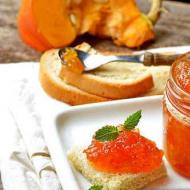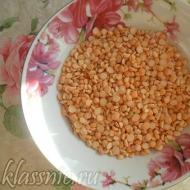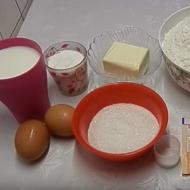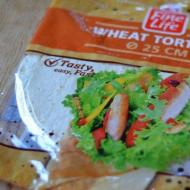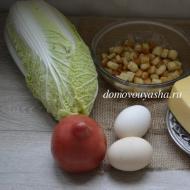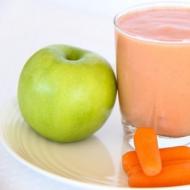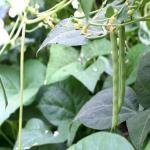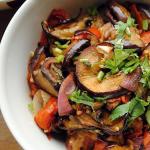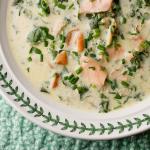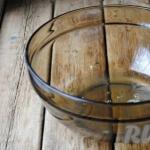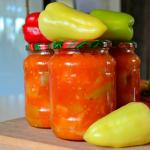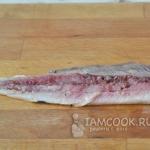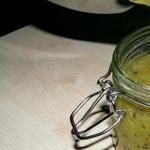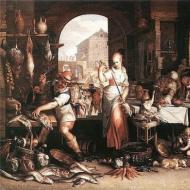
Preparing lunch while camping. Recipes for camping dishes. Healthy breakfast with vegetables
There are probably no people who don’t like hiking. It’s just difficult to get ready, but the process itself is very exciting, filled with various adventures and pleasant gatherings around the fire. But in order to feel comfortable, you need, first of all, to take care of your nutrition. After all, walking causes an appetite, and if you consider that a lot of energy is spent during a hike, then the food should be complete and high-calorie.
Do not forget that you need to take products with a long shelf life. All homemade “salads” must be eaten on the first day. Everyone knows that a constant attribute of a tourist is canned food. However, do not forget that they weigh a lot, so you will have to carry this load on your back. Calculate how many cans you need. Also, experienced tourists advise taking only stewed meat. This is meat that will add strength. You shouldn't take canned fish. They make you very thirsty, and catching fresh fish on a hike is not a problem. Take with you different types of cereals, if possible some potatoes, lard and onions, salt and various spices.
The hike will give you new tastes of familiar dishes
And now, finally, a halt and you can start cooking.
Porridge
A tourist's first food is porridge. Everyone prepares it the old fashioned way: boil water and pour in cereal. But it's better to do it this way. Soak the cereal in water. Then hang the pot on the fire and add finely chopped lard and, later, onions. After all this has thoroughly simmered, add the cereal. If necessary, add a little water, add salt and bring to a boil. That's all, the super porridge is ready. Believe me, your friends will be surprised by the new taste of simple porridge. You can use any cereal, but it works best with buckwheat or pearl barley.
Ear
How can you not cook fish soup while camping, especially since everyone loves to go fishing in the evening. Please note that for a good fish soup, it is advisable to use different types of fish. When the water boils in the pot, throw in the bay leaf. Carefully wrap the fish in gauze and lower it into the water. Then add potatoes. It should be coarsely chopped. In principle, nothing else is needed for fish soup, however, many people add pearl barley. As they say, not for everybody. When the fish soup is almost ready, you need to add 100 grams of vodka to the soup. Don't forget to add spices to taste. And the final touch of culinary art: before serving, take a branch from the fire and put it out in the pot. This will give the ear a special aroma.

Potato
Many people cannot do without potatoes; well, people cannot get enough without them. Of course, you can approach cooking potatoes formally, or you can use your imagination. It can be baked in coals. Although this is more difficult, it is still better than simply boiling it in a pot. If you're going to cook, do it in uniform!
Stew
Stew is the favorite dish of all tourists. You can, of course, heat it up by the fire and eat it like a hot dish. But this will be irrational. It is best to add it to porridges and soups. After all, then the dish becomes richer, higher in calories, and most importantly, much tastier. Before serving porridge or soup with stew, add raw branches to the fire to create thick smoke. The porridge will definitely absorb it and acquire a completely unique taste. Believe me, your colleagues have never tried such a dish with the aroma of real forest smoke.
Tea
If you forgot to take tea with you, it doesn’t matter. It is impossible to remain in the forest without this drink. Believe me, herbal teas will replace the best Ceylon tea for you.
When cooking on a hike, feel free to experiment, because hungry hikers are omnivores!
Many of us love to go on real multi-day hikes - with backpacks on our shoulders, tents, a fire, a guitar and a cheerful company, or on small weekend hikes. At the same time, for lovers of this type of recreation, the weight of the camping belongings is very critical, since they have to carry it on themselves. Experienced travelers know that the hardest thing is food, so let's try to create a tasty, satisfying and original hiking menu for one day, using a minimum of ingredients.
Breakfast
According to popular wisdom, you need to eat breakfast yourself, share lunch with a friend, and give dinner to your enemy. For camping life, this is almost completely true; at least the first meal should be really filling, because there is a long and difficult day ahead. Therefore, we will bake pancakes for breakfast.

To prepare them you will need:
- 500 ml of water (spring water is possible);
- 300 grams of wheat flour;
- 2 tablespoons sugar;
- 0.5 teaspoon salt;
- 70 ml vegetable oil;
- 1 teaspoon baking powder.
Pour flour, sugar, salt into a saucepan and pour water into the resulting dry mixture in a thin stream, after heating it a little in the sun. This must be done carefully so that the flour does not stick together and lumps do not form. Then add baking powder, 50 ml of vegetable oil and mix thoroughly. The dough is ready - you can bake it.
These pancakes are baked over coals in a well-heated frying pan greased with the remaining sunflower oil. At the same time, you need to carefully monitor them - without eggs, the dough quickly burns. You can eat these lean pancakes with tea and condensed milk.
By the way, since our frying pan is heated, we can also make popcorn, which will be an excellent addition to pancakes and a wonderful snack on the road.

You will need:
- 100 grams of corn grains for popcorn (ready-made packages are sold in all stores);
- 50-60 grams of sugar;
- 100 grams of peanut butter;
- salt;
- vegetable oil.
Heat the vegetable oil in a frying pan and add the “half-cooked” popcorn there. To find out if the oil is hot enough, throw one grain into the frying pan; if it quickly floats to the surface and “explodes,” you can fry. Once toasted, place the popped corn into plastic containers.
If you prefer your popcorn salted, salt it generously. And if it’s sweet, melt sugar and peanut butter in an aluminum mug and pour the resulting syrup over the popcorn.
Dinner
For normal bowel function while hiking, it is very important to eat liquid food at least once a day. Therefore, for lunch, for starters, we will prepare a simple bean soup, as well as a light vegetable salad.

- 1 can of canned chicken (for example, “Boiled chicken”, “Chicken fillet in jelly”, etc.);
- 2 cans of canned beans;
- 1 slice of bacon;
- 2 large onions;
- half a medium head of cabbage;
- 3 cloves of garlic;
- 1 tablespoon salt;
- 4 tomatoes;
- spices to taste.
In a well-heated camping pot, fry a slice of bacon so that it releases its fat and flavor. Then remove the pork, cut the onion (1 onion) and fry it until lightly golden. Add the garlic and spices and fry for about another minute. Meanwhile, cut the tomatoes (2 pieces) and shred the cabbage (not all - half!). Fill the roast with a small amount of water, add vegetables and canned chicken. Cook for 15 minutes. Then add the beans and keep on the fire for another 10-15 minutes. At the end of cooking, check for saltiness and spiciness.
The result is a very satisfying and tasty soup.
For the second course we prepare cabbage salad.

For this we need the remaining vegetables from the soup:
- 1/4 head of cabbage;
- 2 tomatoes;
- 1 onion;
- 1 can of canned green peas;
- mayonnaise;
- salt and pepper to taste.
The recipe is simple: cut the cabbage and tomatoes into strips, drain the water from the peas and add it to the vegetables. Salt, pepper and season with mayonnaise. A light but quite filling salad will be the perfect end to a camp lunch.
Dinner
Dinner for travelers is usually late. Once the fire burns down, you can cook many delicious dishes over the coals. Eg:
Baked potatoes and corn

Ingredients:
- 1 kg of potatoes;
- 5-7 corn on the cob;
- bacon;
- salt and spices.
The potatoes need to be peeled, washed and cut like an accordion - several times on one side. Stuff the resulting holes with bacon (there is a little left from the soup). Salt and pepper the potatoes, wrap them in foil and place them on hot coals. And after it we put corn - unhusked, right on the cob. In 30-40 minutes, dinner is ready. Bon appetit!
When hiking, all the food turns out surprisingly appetizing! We often remember the taste of this particular food and even try to recreate it at home.
But alas, this is impossible! Because in camp food you can feel the taste of nature itself, in whose bosom everything is prepared. So gather your friends, put on your backpacks, read our recipes and go!
Traditionally, bigos is made from sauerkraut and meat, and the version of the dish that you will see below is slightly different from the original. Plus, the guys were lucky to shoot a duck on the hike, so they decided to smoke it in a camp smokehouse and add it to the stew. If you don’t shoot the duck, don’t despair, your bigos will turn out delicious without it! Now let’s find out all the secrets of preparing this delicious dish.
What you will need to prepare camping bigos:
- Stew (preferably beef) - 2 large jars of 500 g each;
-Fresh cabbage - 500 g;
-Tomatoes - 3 pcs.;
-Bell peppers - 2 pcs.;
- Hot pepper - 2 pcs.;
-Onions - 3 pcs.;
-Carrots - 1 pc.;
-Apples - 3 pcs.;
-Garlic - 1 head;
-Raisins (seedless) - 70 g;
- Salted parsley and dill prepared at home for the hike - 3 tbsp. spoons (can be replaced with dried parsley and dill);
-Vegetable oil -50 gr.;
-Black pepper - to taste, 4 bay leaves;
-Salt - to taste;
So, let's attend 
1. If you have a duck and a portable hot smoker, that's a plus. A few words about how to smoke game. It is necessary to pluck, singe, gut and rinse freshly caught game with cold water. Next, sprinkle it with salt and pepper both outside and inside and leave for about 30 minutes. Place a couple of good handfuls of alder chips on the bottom of a clean, fire-burned and already cooled portable smokehouse (it can be replaced with bird cherry branches, which can usually always be found in the taiga). Place a special spreader for fat on top of the wood chips, then a grate, and finally, a wild duck carcass prepared for smoking, belly up. Close the smokehouse and leave the duck there for 40 minutes on well-heated coals.
2. Remove the fat from the stew (this is what the bigos will be cooked in).
3. Place the fat in a cauldron or cauldron, set it on fire, and as soon as the fat is well heated and boiling, add coarsely chopped onions to the cauldron (one onion head should be left).
4. When the onion becomes translucent (after 5-7 minutes), add sliced carrots to it.
5. After 7 minutes of frying the onions and carrots, shredded fresh white cabbage is sent into the cauldron. 
6. Then, pour about 150 milliliters of boiling water into the cauldron, after which you need to close it with a lid and simmer the vegetables at a moderate temperature for about 1 hour, and while the vegetables are stewing, prepare the remaining ingredients.
7. Cut the garlic and hot pepper into thin slices and place them in a separate bowl.
8. Separately cut the tomatoes into small cubes.
9. Cut the bell peppers into small pieces and wash them, and then soak about half a mug of raisins in boiling water.
10. Cut the finished smoked duck into small pieces. 
11. After which, fry the game with the remaining onion in a small amount of vegetable oil. We put the resulting frying aside for now.
12. Cut raw smoked sausage or any sausage at your disposal into small cubes.
13. After an hour of stewing the base of our bigos - cabbage, add the sausage to the cauldron, mix, and simmer the vegetables and sausage for about 10 minutes.
14. Next, two cans of stew are sent to the cauldron,
15. Then, frying onions and smoked game is added. 
16. Mix everything thoroughly, after which the cauldron with bigos is closed with a lid and placed on moderate heat, where the dish is simmered for another 40 minutes.
17. Next, tomatoes with garlic and hot pepper are placed in the bigos.
18. Next, bell peppers with canned herbs. Now the bigos needs to be placed over the fire again, the contents of the cauldron simmered for about 15 minutes over moderate heat, after which sliced apples (which are previously peeled and cored), several bay leaves and black pepper to taste are placed in the cauldron. 
19. Next, soaked raisins are added to the bigos, and now it’s time to try what happened with salt (stew and sausage give a little salt), add salt to taste.
20. Stir again very well, simmer the bigos under a closed lid over very low heat (or better yet, over coals) for the last 30-40 minutes, and finally (if you haven’t been killed by hungry tourists by this time), serve the bigos to the camp spread the dish into bowls on the table.
It is worth noting that this dish took about 4 hours to prepare, and real bigos is prepared 2 days before the intended meal. There is not that much time on a hike, but the guys were not at a loss and left the bigos on the coals to cook for another 5 hours. The result was excellent. 
This borscht will perfectly satisfy your hunger during the day, and its taste is absolutely amazing!
What is needed to cook borscht with mushrooms and stew in a pot:
-For a 5 liter cauldron - stew - 1 large can (pork or beef)
-Potatoes - 4 pcs.
-Carrots - 1 pc.
-Onions - 3 pcs.
-Mushrooms (any mushrooms will do, for example: white mushrooms, boletus, boletus, chanterelle) - 0.5 kg.
-Tomatoes - 2 pcs.
-Bell peppers - 3 pcs.
-Cabbage - 1/4 fork
-Garlic - 1/2 head
-Ketchup - 2 tablespoons
-Vegetable oil - for frying (can be replaced with fat from stew)
-Dry seasonings and seasonings for soup, special seasoning for borscht (contains beet granules), -suneli hops, black pepper - to taste
-Salt
Well, shall we feed the tourists some borscht? 
1. Sort the mushrooms, peel, chop and soak for 15-20 minutes in slightly salted cold water, cut the onion into medium cubes.
2. Place a frying pan on the coals and pour a little vegetable oil into it (can be replaced with fat from the stew). Once the oil is hot, lightly fry the onion.
3. Then, pour the mushrooms into the frying pan (the salted water must be drained before doing this, and the mushrooms must be squeezed out), and fry the mushrooms and onions for about 15 minutes.
4. Remove the first roast for borscht from mushrooms and onions from the coals, add a little salt and pepper with black pepper.
5. Prepare the products for the second frying. Cut the remaining onions into medium cubes and cut the carrots into small cubes (if you have a grater on your camping trip, it’s better to use it).
6. Dump the fat from the can of stew into the frying pan (or use vegetable oil if you have it). 
7. Melt the fat over coals and fry the onion on it until transparent,
8. Then add chopped carrots to the onions,
9. As soon as the carrots become golden, add about two tablespoons of tomato ketchup to the frying.
10. Fry the vegetables with ketchup for another 10 minutes, avoiding burning. As soon as the second frying for borscht with mushrooms is ready, remove the frying pan from the heat, and it will be the best time to hang a cauldron with cold water over the fire... While the water in the cauldron is brought to a boil, we begin to prepare the vegetables for our borscht with mushrooms.
11. Shred the cabbage as thinly as possible.
12. Cut the tomatoes into small pieces, peel the bell peppers from seeds and cut them into half rings, also peel the garlic and cut into thin slices. 
13. Peel and cut potatoes.
14. Pour cabbage into boiling water.
15. Then, add the stew to the borscht, let the cabbage and meat simmer for 10 minutes.
16. Pour potatoes into the cauldron.
17. Next, after 5 minutes, dump the first mushroom fry into the cauldron with borscht. 
18. After another 5 minutes, after the borscht boils, pour the fried onions and carrots into the soup.
19. Next, while the soup is cooking, prepare dry seasonings for soup, seasoning for borscht, hops-suneli, salt, pepper, etc. in a separate plate, after which we pour the contents of the plate into the borscht and mix everything thoroughly,
20. Another 5 minutes after adding dry spices to the borscht with mushrooms, pour tomatoes, garlic, and bell peppers into the soup,
21. Cook the borscht with mushrooms over moderate heat (so that it barely gurgles) for another 20-30 minutes, after which we invite friends and enjoy the taste. 
Everyone will definitely like the recipe for pea soup with smoked meats, especially if you get wet by unscheduled rain and need something to warm up.
What you need for a delicious smoked soup
-Water from a mountain stream - 4 liters.
-Peas - 500 gr.
-Beef (or pork) stew - 1-2 cans (depending on availability)
- Raw smoked or any smoked sausage - 150 gr.
- Potatoes - 2 pcs.
-Onions - 1 pc.
-Garlic - 5 cloves
-A mixture of dried onions and carrots (if not available, replace with 1 more onion and 1 carrot)
-Bouillon cubes of the “maggi” type - 2 pcs.
-Spices (any you like), bay leaf, black pepper, salt
-Vegetable oil - 2-3 tablespoons for frying (can be replaced with fat from a can of stew)
So, let's prepare the soup 
1. First you need to soak the peas. You can simply put it in a mountain stream for 20 minutes and it will wash itself, but you can devote 3 minutes to this activity and use your hand to stir the peas in ice water, constantly draining the water until the peas are thoroughly washed. Immediately a recommendation to the topic: if you are not on a working day, and you do not have an hour of free time to cook only peas for your soup, you can soak them in advance for 10-12 hours (for example, overnight) and then they will cook three times faster.
2. When the peas are washed, we go to make a fire and hang a cauldron of water over it, after which, without waiting for the water in the cauldron to boil, we pour the washed peas into the cauldron and immediately stir it.
3. While the peas are cooking (in total, this will take about 50-60 minutes), peel the vegetables.
4. As soon as the water begins to boil, foam will immediately begin to form in the boiler, which is highly advisable to remove immediately as it forms.
5. After about 15-20 minutes of boiling water, you can pour a mixture of dried onions and carrots into the cauldron; if there is no mixture, but just fresh carrots, then you can finely chop it and throw it in now or include it in the frying composition for a richer taste. 
6. Frying is done as follows: place a frying pan or a boiler lid over the coals, and without waiting for it to heat up, put smoked sausage cut into small pieces on it (we need the fat to start melting out of the sausage),
7. Cut the onion into thin half rings and pour it on top of the smoked sausage
8. While the fat from the sausage is rendering, you can open a can of stew and chop pieces of stew with a knife.
9. As soon as the sausage begins to grit slightly in its own fat, pour in a few tablespoons of vegetable oil (or fat from an open can of stew), and, stirring periodically and monitoring the intensity of the heat of the coals (to prevent burning), bring the frying to full readiness.
10. While the frying is being prepared, cut the potatoes into small pieces and pour them into the cauldron,
11. As soon as the frying is done and the sausage and onions have a “fried look”, put it aside for a while. 
12. About 5 minutes after putting the potatoes in the cauldron, we put the stew there too,
13. Next - a couple of bouillon cubes,
14. After 10 minutes, the sausage and onion frying is added to the soup. At approximately this point, you need to check the soup for salt, and if necessary, add salt to taste.
15. Next, immediately add into the pea soup not very finely chopped cloves of garlic and a little black pepper, bay leaf and any spices that you like and that you took with you on the hike.
16. After adding the spices, let the soup simmer for 5 minutes, then remove it and let it brew for another 10-15 minutes. Fry the bread until golden brown and hurry up and pour yourself some soup before your fellow hikers gobble it up completely! 
On almost any trip you manage to collect a certain amount of mushrooms, so add this recipe to your piggy bank and please your tourists with a delicious and aromatic julienne.
What you will need for julienne of wild mushrooms:
-Forest mushrooms - 300g.
-Onion - 1 head;
-Garlic - 5 cloves;
- Powdered milk - 3 tbsp. spoons;
-Mayonnaise - 2 tbsp. spoons;
-Grated cheese - 4 tbsp. spoons
-Vegetable oil - 5 tbsp. spoon;
-Ground coriander - 1 teaspoon;
-Dry dill - 1 teaspoon;
-Salt - to taste;
How to prepare it: 
1. Clean the mushrooms and cut them either into julienne (thin strips) or into thin slices.
2. Onions - small cubes.
3. Dilute 3 tablespoons of dry milk with warm water and mix thoroughly and break up the lumps - this will be the basis of the julienne sauce.
4. Place a saucepan on the primus stove, pour in a little vegetable oil, heat it well and quickly fry the onion until translucent.
5. Add the mushrooms to the onion, and stirring occasionally so as not to burn, fry the contents of the pan for 10 minutes.
6. While the mushrooms and onions are frying, cut the garlic into julienne or thin slices. 
7. Mix the julienne well, and after 10-12 minutes of frying the mushrooms, pour the diluted dry milk into the pan,
8. As soon as the contents of the pan boil, add a little mayonnaise, then simmer over low heat for another 5 minutes, after which add dry parsley, coriander and black pepper to the pan to taste. Let the appetizer simmer for another 2 minutes.
9. Sprinkle the dish liberally with grated cheese, mix everything well, check for salt (cheese and mayonnaise are salty!) and, if necessary, add salt to taste,
10. Add garlic, mix, then simmer over low heat for another 3 minutes, after which the dish can be served at the camp table. 
It happens that some food is left behind during a hike. In this case, cabbage and carrots were left over, as a result of which an amazing pie was prepared in a camp oven.
So, for the cabbage camp pie, let's take:
- Cabbage - 500 g;
-Carrots - 1 pc.;
-Onions - 2 medium heads;
-Flour - 1 kg;
-Yeast - 1 package;
-Sugar - 1 tbsp. spoon;
-Vegetable oil - 7 tbsp. spoon;
- Ground black pepper - to taste;
-Salt - to taste
Let's start cooking 
You can bake a pie in a smokehouse, burying it in the coals of a fire, or you can try to build such a stone wood-burning oven.
1. The oven needs to be heated well, so we light it, fill it with wood and go put the dough and prepare the filling for the pie.
2. The dough is easy to prepare. Dilute one heaped tablespoon of sugar with a glass of warm water, add a teaspoon of salt, dissolve everything well and pour out a package of quick-acting yeast, wait about 5 minutes. Next, pour a kilogram packet of flour into a deep bowl, make a well in the middle of the heap of flour, pour in Mix the resulting dough into it, add a little more water. Next, the dough needs to be covered and exposed to the sun so that it rises. In the meantime, you can start filling.
3. Finely chop the cabbage, grate the carrots on a coarse grater, put everything in a separate bowl, and sprinkle a little salt.
4. Mix the cabbage and carrots thoroughly with your hands so that the cabbage becomes soft.
5. After that, put a cauldron on the fire, pour a little vegetable oil into it, fry a couple of onions cut into small cubes in oil, add cabbage and carrots to the onions, fry a little with the onions. Now you need to add a little water, cover the cauldron with a lid and simmer our pie filling for 10-15 minutes over moderate heat until fully cooked. After preparing the filling, it is advisable to cool it a little, for which you can simply place the cauldron with cabbage for 10-15 minutes in a mountain stream or river! 
6. To slightly reduce the heat, the author of the recipe took his camp smokehouse, installed a grate, placed a tray on it to collect fat, covered it with two layers of usually aluminum foil, and on top of the foil, laid a layer of half the resulting dough.
7. Place the cabbage filling on top of the laid out dough, having previously separated all the excess liquid from the filling, cover the cabbage with a second layer of dough.
8. We carefully pinch all the edges of the pie, make one or two holes for steam to escape, then give our pie another 10 minutes for the dough to rise. 
9. Bake the cabbage pie for 20-25 minutes, determine readiness by checking the dough by piercing it with a splinter.
10. Take the cake out of the oven and let it cool, after which we cut it into portions and treat it to everyone present. 
What we need for a delicious pilaf on a hike:
For a 5 liter cauldron:
-1.5 kg of meat;
- 1 kg of onions and carrots;
-800 grams of rice;
- spices to taste;
-2-3 heads of garlic.
Cooking aromatic pilaf in a cauldron 
1. Pour oil into a hot cauldron and let it warm up.
2. Add onion.
3. When the onions are a little tired, add the carrots and mix.
4. When the onions and carrots are almost cooked, add the meat and mix.
5. Add spices. Better by weight and preferably with the addition of barberry and cumin! 
6. After the meat is cooked, add rice (steamed) in an even layer.
7. Fill with cold drinking water.
8. Pour water so that it covers the rice by 2 fingers... (the main thing is not to overfill the water)
9. Salt and after the water has boiled away on the surface, add the heads of garlic.
10. Cover with a lid and forget for 40 minutes.
Then you won’t be able to drag away hungry tourists by the ears! :)  What is needed for pounding in field conditions?
What is needed for pounding in field conditions?
-Semi-finished mashed potatoes - 1 package;
-Ham - 1 can;
- Powdered milk - 4 tbsp. spoons;
-Onion - 1 head;
-Garlic - 5 cloves;
-Vegetable oil - 4 tbsp. spoons;
- Ground black pepper - to taste;
-Salt - to taste; 
1. Cut the onion into small cubes.
2. Cut the garlic into pieces.
3. We take only the ham out of the jar (not all the contents), and, placing it on a board, cut it into small pieces.
4. Next, heat a small amount of vegetable oil in a frying pan and start frying those same chopped pieces of ham.
5. As soon as all the excess fat has been rendered from the ham, add chopped garlic and onion, add pepper, and fry for another 1 minute.
6. Carefully transfer all large and whole pieces of ham from the frying pan into a separate bowl. 
7. Place everything that is left in the jar into the frying pan and fry it all for 2 minutes!
8. Now you can prepare the puree. We dilute the powdered milk in a mug, and put 1/2 liter of water on the fire until it boils (for more precise proportions of water and milk, check the instructions for mashed potatoes).
9. When the water has boiled, pour in the diluted dry milk, and add the mashed potato powder while stirring constantly, at the same time beat the mashed potatoes with a spoon and add our frying from the frying pan to it.
10. Stir the frying mixture into the potatoes until smooth. If necessary, add salt to taste. Let's serve.
The author uses dry potato concentrate, but you can also use regular potatoes - whoever has what! Of course, with regular potatoes you will get a dish that is both tastier and healthier than with concentrate, the only advantage of which is that you don’t have to carry bales of potatoes with you. :) 
Probably one of the most favorite tourist recipes, the taste of which is familiar to everyone who has ever been on a hike!
What do you need for potatoes baked in ash?
Potatoes - as much as you like
Bonfire with a pile of ash
Good old recipe 
1. To cook potatoes you need a long-burning fire. Carefully move the fire to the side, and in the place where it was, use a spatula or stick to dig a hole in the ash.
2. Place pre-washed and clean potatoes (preferably dry) into the prepared hole.
3. Bury it with ash so that the layer of ash above the potatoes is at least 5-7 centimeters (otherwise the potatoes will burn during casserole!)
4. In place of the potatoes just buried in the ashes, make a larger fire again and maintain it for 1 hour.
5. After the specified time, we dismantle the fire, and carefully raking the coals and ash, we take out our fully baked potatoes.
Let's eat! 
There are a great many recipes for successful fish soup and here is just one of them!
Some tips for cooking fish soup
1. It is best to take water from a reservoir, this will give the fish soup that unique taste. However, if the pond is polluted, it is better not to do this.
2. Do not cook crucian fish soup!!! The soup will be bitter and have an unpleasant smell and taste. If the pond is crucian carp, then soak the fish in salt for at least 30 minutes, or even better in water with vinegar. Also, do not cook fish soup from catfish and tench.
3. The fish soup is cooked only with the lid open! After cooking, remove the pot and only then cover it with a lid for a few minutes!
How to cook fish soup: 
1. Take the fish, clean it from scales, gut it, remove the gills and eyes.
2. Throw the heads and tails into the boiling water of the cauldron and boil for 15-25 minutes (on a low simmer).
3. While the heads are boiling, we make fish fillets, which we will then cook and eat.
4. Prepare potatoes, carrots and onions. Many people boil potatoes and onions whole, but you can also cut them. A matter of taste!
5. Remove the fish heads and tails from the pot and throw in the carrots and potatoes (the potatoes can be thrown in a little earlier, because they take a little longer to cook). When the potatoes are almost half ready, add the onions and fish pieces that we will eat directly.
6. After 10 minutes, add herbs, salt, bay leaf. We also take a firebrand of coal (preferably birch) and, after shaking off the ash, throw it in the ear for a minute. It will draw out all third-party odors.
7. A few minutes before the end, add a little vodka. When added, it evaporates and the temperature of the fish soup increases. This helps the fish meat to be softer.
After this, the soup is ready and can be safely eaten. The main thing is to cook at a low simmer; this largely determines the success of the fish soup.
If you don’t agree to have breakfast in nature with instant noodles or heated canned food, you can quickly and easily prepare yourself an almost usual breakfast. For some dishes you'll need a pot, a frying pan and a grill rack, others can even be prepared in a paper bag or freezer bag. Here are 16 recipes for a delicious camping breakfast.
1. Blueberry pie in foil
Blueberry pieFor this pie you will need eggs, milk, sour cream, sugar, cinnamon, blueberries, plain white bread and foil. Eggs, milk, sour cream, sugar and cinnamon can be mixed ahead of time and transported in an airtight food container.
Already in nature, finely chop the bread into a bowl with the mixture and add blueberries. Wait until the bread is sufficiently softened and divide the mixture into portions. Bake each portion separately in several layers of foil.
It is better to bake the pie on a wire rack over a fire for 25–30 minutes. Once cooked, you can serve directly in foil.

2. Small sausage and egg burgers
 Morning hamburger
Morning hamburger For this dish, you will need a special biscuit pan, which you can buy on Amazon. First, cheese buns are prepared from individual ingredients.
 Cheese buns
Cheese buns Mix flour, baking powder, salt, milk powder, sugar and butter in a bowl and take this mixture with you in a food container.
In the morning, grease the molds with oil, add grated cheese to the mixture and place the dough in each mold of the pan. Dilute the dough in each mold by adding 50 grams of water and toast the buns.
 Scrambled eggs for hamburger
Scrambled eggs for hamburger After that, all the ingredients are combined into one big and tasty hamburger.
 All ingredients
All ingredients 3. Blueberry-orange muffins
 Blueberry-orange muffins
Blueberry-orange muffins To make camp muffins you will need oranges (one orange - one muffin), dough and foil. Make muffin batter with blueberries or other ingredients at home and take it with you in a food container.
Cut the orange in half and scoop out the pulp with a spoon. Place the muffin batter inside, cover the orange with the other half of the peel and wrap in three layers of foil.
 Muffins in foil
Muffins in foil Broil muffins, turning occasionally, for 10 minutes. When the ball in foil becomes hard inside, you can take it out.
4. Scrambled eggs in a bag
 Scrambled eggs and bacon in a bag
Scrambled eggs and bacon in a bag You can cook bacon and eggs in a regular paper bag. First, cut the bacon into slices and line the bottom of the bag. Break an egg on top of the bacon.
 Break the egg into the bacon slices
Break the egg into the bacon slices Keep over the fire until the egg is fried. You can eat straight from the bag, but be sure to place the bag on a plate to prevent bacon grease from staining your clothes.
5. Sausage casserole
 Sausage casserole
Sausage casserole As in previous recipes, the dough can be prepared at home and taken with you. Mix flour and cornmeal, salt, sugar and baking powder, add milk, eggs and butter.
Heat the oil in a frying pan on a grill rack and brown the sausages. Place them on a separate plate and pour the casserole mixture into the pan. When it's golden brown, place the fried sausages on top.
6. Healthy breakfast with vegetables
 Healthy breakfast
Healthy breakfast Place sausages or pieces of bacon on several layers of foil, and diced potatoes and tomatoes on them. Break an egg on top and sprinkle with green onions.
 Ready mixture in foil
Ready mixture in foil Wrap in foil and bake over a fire on a grill rack. When the dish is ready, open the foil and sprinkle with grated cheese.
 One minute before it's ready
One minute before it's ready Wait a few more minutes for the cheese to melt and your healthy breakfast is ready.
7. Beer pancakes
 Beer pancakes
Beer pancakes If you have a frying pan, you can bake beer pancakes in the morning. Instead of water, add 0.5 liters of dark beer to the usual pancake dough (300–400 grams of flour, two eggs, two tablespoons of vegetable oil, sugar and salt).
This recipe originally called for Guinness, but any other dark beer can be added.
8. Cinnamon cake on a stick

Make it at home or buy biscuit dough and bring it with you. Find a stick that is strong and small enough, peel it and wrap it around the dough.
Wrap so that the layers of dough do not lie on top of each other, otherwise the biscuit will not bake. Cook over the fire until the dough is lightly browned, then sprinkle the finished cake with sugar and cinnamon.
9. Stew on a frying pan

Chop the bacon, onion, baked potato and orange pepper. Fry in a pan on a grill rack.

To prepare it, you will need a special small sandwich mold, for example this one. Everything is simple with it: you put bread in a frying pan, break an egg on top, cut up a sausage and grate cheese.

Cover the filling with a second slice of bread and pour mayonnaise over it. After this, the sandwich is baked in a metal pan over a fire.
11. Bacon on the fire
 Bacon on the fire
Bacon on the fire To ensure that the bacon is evenly cooked and crispy, you need to put it on the skewer in a special way. Thin strips of bacon are strung in waves, so that the layers do not touch each other.
12. Omelette in a freezer bag

For this dish you will need a freezer bag and a saucepan or kettle. Break two eggs into a bag, close it and shake thoroughly until the yolk and white are mixed.
Then add the other ingredients you want the omelet with, such as bacon, hot dogs, sausage, green bell peppers, green onions, or anything else, to the eggs.
Release the air from the bag and close it, place it in a pot of boiling water and cook for about 12 minutes. After this, all that remains is to place the finished omelette on plates.
13. Scrambled eggs in orange
 Scrambled eggs in orange
Scrambled eggs in orange This recipe is similar to orange sponge cake, but uses eggs instead of dough. Simply scrape the orange pulp out of the peel, crack two eggs into it, wrap it in foil and cook over a fire for 10 minutes. Be sure to turn the balls in the foil over from time to time to prevent the dish from burning.
14. Instant oatmeal

Mix dry oatmeal with chopped nuts and dried fruits and take this dry mixture with you in an airtight container.
In the morning, all you have to do is fill it with water, cook it in a camp saucepan and add chopped fresh fruits, such as apples or apricots.

You will need biscuit base, brown sugar, cinnamon, one large apple and raisins. Place the biscuit base in a shallow pan to form cakes about 10cm in diameter.
Sprinkle this sponge circle with a mixture of sugar and cinnamon, top with a thin layer of apples (8-10 very thin pieces) and raisins. Cover with the second sponge cake, connect the edges so that the filling does not fall out, and place in a container.
Outdoors, bake the pie in a greased frying pan over coals until golden brown. Turn over every two minutes.
16. Omelette with biscuits

For this breakfast you will need a frying pan with a lid. In a frying pan you will cook an omelet from eggs, onions and bell peppers, and on its closed lid you will fry biscuit buns. It turns out quickly and tasty.
Do you have your favorite camping breakfast recipes?
Camping recipes
Weekend hikes are available to everyone. As a rule, tourists participate in them with their whole family. Such a hike is a holiday, especially for children. Therefore, from the point of view of food and diet, tourists try to make their diet festive, especially since such hikes do not have too difficult obstacles or heavy backpacks. You can take any food on a weekend hike, since they all can be stored for 1-2 days .
Here you should not get carried away with canned food or concentrates. It is better to prefer fresh vegetables/fruits, dairy products and fresh meat products. For 1- and 2-day hikes, it is advisable to mainly prepare food at home. But you should not rely entirely on personal initiative. This leads to the fact that each tourist sets out on the route with only 3 elements: hard-boiled eggs, sausage sandwiches and cheese sandwiches. The smartest ones also take salt with them. This traditional “diversity” in no way corresponds to the general high spirits. It would be good if someone figured out how to string this boring sausage onto a twig and fry it over the fire. Therefore, even during a 1-day hike, you should appoint a caretaker, whose functions include developing a menu and personally distributing the preliminary preparation of certain dishes among the hike participants.
It is difficult to give specific recipes for certain dishes here - any of them can be used on such trips. It is important to remember that 1- and 2-day hikes are a vacation, a holiday. Therefore, everything here should be festive - the mood, the appetite, and the nutrition.
Multi-day category trips are another matter. This is already work. It’s not really possible to take all sorts of pickles with you. You won’t be able to take with you not only potatoes or cabbage, but even fresh bread. How to provide the required variety of dishes?
Below are recipes for dishes, the preparation technology of which and the range of ingredients that comprise them fully correspond to camping conditions.
First meal
Noodles. 1 bouillon cube per person. Noodles or vermicelli 30 g each. Spices. Butter (melted) 1 tablespoon.
Place pre-mashed bouillon cubes into boiling water and stir. Add noodles or vermicelli and cook the soup, stirring, for 15-20 minutes. 5 minutes before the end of cooking, add 1-2 tablespoons of dry vegetable seasoning such as “Appetit”, “Veda” or “Yazhinka”. Do not add salt to the soup, as salt is contained in both the bouillon cubes and the seasoning. Individual salting of soup is allowed.
Broth with dumplings. 4 bouillon cubes per person. A glass of flour. Butter (ghee) 3 tablespoons. Egg powder 1/2 tablespoon.
Pour a glass of water into a bowl, add butter, boil, throw in half a bouillon cube, stir. Add the cereal, stir, heat for 1-2 minutes, and then, removing from heat, add egg powder and mix thoroughly. Meanwhile, boil the amount of water required for the broth in a saucepan, put the previously mashed bouillon cubes into the boiling water, and stir. Drop the prepared dough into the boiling broth in small portions (1/4 tablespoon each). Readiness is 2-3 minutes after the dumplings rise.
Bean soup with meat. Canned meat 800 g. Canned beans in tomato sauce 850-1000 g. Boiled-smoked brisket or loin 250 g. Spices. Salt to taste.
Place finely chopped brisket or loin into boiling iodine, and then the beans. Let it boil for 5 minutes. Place the meat, add 1 spoon of dry vegetable seasoning. 5 minutes after the next boil, the soup is ready. I can serve white bread crackers with the soup.
Green cabbage soup with meat. Canned meat 500 g. Young nettle 400 g. Sorrel (or sorrel) 200 g. Wheat flour 1 tablespoon. Fat 2 tablespoons. Spices. Salt 1/2 teaspoon.
Boil water in a saucepan in the amount necessary to prepare the first course for the whole group. Sort out the nettles, rinse well, cook in boiling water until soft, place on plywood, chop finely. Temporarily pour the broth into another container. Sort the sorrel, wash it, cut large leaves. Melt the fat in a saucepan, add flour and fry, stirring. Then put finely chopped nettles into a saucepan, mix well, dilute with the hot broth left over from boiling the nettles. Add bay leaf, pepper and cook for 15-20 minutes. 5-10 minutes before the end of cooking, add sorrel leaves, salt, and meat to the pan.
Kharcho. Canned meat 500 g. Rice 1 cup. Dried onion 30 g. Garlic 15 g. Ghee (butter) 1 tablespoon. Tomato puree 2 tablespoons. Spices. Salt 1/2 teaspoon.
Place the washed rice in a pan of boiling water. It should cook for 40-45 minutes. During this time, lightly fry the tomato paste in a bowl of oil. 20 minutes before the end of cooking the rice, put the onion, crushed garlic, black pepper (15-20 peas), suneli hops 1/3 teaspoon, and salt into the pan. Add fried tomato paste to the soup 10 minutes before. In 5 minutes - meat. It is very good if you can serve freshly picked wild garlic leaves with the soup.
Fishing soup. Small fish 1.5-2 kg. Large fish 2.5-3 kg. Dried onions 30 g. Dried carrots 50 g. Dried potatoes 200 g. Spices. Salt 1/3 teaspoon.
Gut small fish, remove gills, and wash carcasses. Divide all this fish into 3 parts. First, cook the first portion of fish in boiling salted water (small fish can be cooked with scales) for 20-25 minutes. Then carefully pour the broth into another bowl, discard the boiled fish, and cook a second and then a third portion in the drained broth, each time draining the broth and discarding the boiled fish. Finally, add black pepper (10-12 peas), bay leaves, onions, carrots and potatoes, as well as prepared pieces of large fish, into the boiling broth filtered through cheesecloth. After boiling again in 20-25 minutes, the soup is ready. Individual salting of the dish is possible.
Mushroom soup with vermicelli. Fresh mushrooms, 200 g per person. Vermicelli 25 g per person. Dried onions 25 g. Dried carrots 30 g. Butter 60 g. Spices. Salt 3/4 teaspoon.
Fresh mushrooms - porcini, boletus, boletus, boletus - clean and rinse. Cut off the roots, chop finely and fry in a frying pan along with onions and carrots in oil. Cut the mushroom caps into fairly large slices, put them in a saucepan, add water and cook for 30-35 minutes. 20-25 minutes before the end of cooking, add vermicelli, mushroom roots fried with onions and carrots, salt, bay leaf, black pepper (3-4 peas).
Semi-liquid dishes
Semi-liquid dishes (kulesh) in terms of thickness occupy an intermediate place between soups and main courses. Tourists most often call this dish “porridge soup.” Since it can replace a 2-course lunch, which saves fuel and time, kulesh is often used in complex tourist trips. True, the thickness here is achieved not by special culinary art, but by simply increasing the filler (cereals, pasta, legumes, canned vegetables, etc.), which does not always lead to maintaining high taste qualities.
Pasta rolls with meat. Canned meat 500-800 g. Pasta 400-450 g. Dried onions 40 g. Tomato paste 2 tablespoons. Butter (ghee) 3-4 tablespoons. Wheat flour 1 tablespoon. One bouillon cube. Spices. Salt 1 teaspoon.
Place the pasta in a saucepan in salted water and cook for 30-40 minutes, depending on the type and thickness of the pasta. Meanwhile, in one bowl, dilute the bouillon cube with 3 cups of the simmering broth from the pan. In another bowl, fry the wheat flour with butter until light yellow and dilute the resulting mass with the cubed broth. In another bowl, fry tomato paste with dried onions and also transfer it to a bowl with toasted flour. Add salt and spices: ground pepper, suneli hops (1/4 teaspoon), bay leaf. Mix everything well. First transfer the cooked pasta to cheesecloth and let the broth drain. Pour out the remaining broth in the pan. Place the hot pasta back into the pan and add oil. Pour the prepared sauce from the bowl here, stir and put on low heat for 20-25 minutes. 10 minutes before the end of cooking, add meat to the pasta. Stir and soon place into bowls. Distribute the sauce that has accumulated at the bottom of the pan evenly among the participants.
Pea kulesh with brisket. Peas 500 g. Smoked brisket (loin) 300 g. Dried onions 40 g. Dried carrots 40 g. Tomato paste 1 tablespoon. Oil 3-4 tablespoons. Wheat flour 1 tablespoon. Spices. Salt 1 teaspoon.
Cook the pre-soaked peas until half cooked (15-20 minutes). Peel the brisket, remove the bones, chop finely, and fry along with the onion. Also chop the carrots finely and fry over low heat along with tomato paste and oil. Fry wheat flour with butter until light yellow in color and dilute with 2-3 cups of pea broth. Add fried brisket and cooked tomato paste here. Drain the half-cooked peas from the pan onto cheesecloth, let the broth drain and put it back into an empty pan, adding a bay leaf, 5-7 crushed cloves of garlic, ground pepper, pour everything over with the prepared sauce, mix well and put on low heat to simmer until tender (about 15 -20 min), stirring occasionally.
Second courses
Millet milk porridge with raisins. Millet 2 cups. Milk 4 cups. Granulated sugar 4 tablespoons. Raisins 3/4 cup. Butter 4 tablespoons. Salt 1/4 teaspoon.
Pour well-washed millet into boiling lightly salted water and cook from the moment of boiling for 10-15 minutes. Then drain the water, pour in hot milk, add 2 tablespoons of sugar. Cook the porridge over low heat until done. Meanwhile, pour the sorted and washed raisins into a bowl, add the rest of the sugar and heat over low heat, stirring, until the raisins have steamed, then mix them with the porridge. When serving, pour oil over the porridge.
Pasta with meat. Pasta 400 g. Canned meat 500 g. Dried onions 30 g. Butter (melted) 4 tablespoons. Tomato paste 1 tablespoon. Spices. Salt 1 teaspoon.
Boil the pasta in salted water until tender. Drain the broth. Place the pasta in a well-heated frying pan with oil and lightly fry, stirring occasionally. Place the meat in a large bowl, disassemble it into small pieces, add onion, finely chopped 5-7 cloves of garlic, tomato paste, stir well and put on low heat. Place the pasta in bowls and place the warmed meat on top.
Omelette. Egg powder 1.5 tablespoons per person. Powdered milk 10 g per person. Butter (ghee) 1 teaspoon per person. Salt.
Pour the egg powder intended for the omelet into a large bowl (1 egg corresponds to 1/2 tablespoon of egg powder) and pour in the prepared milk at the rate of 1/3 cup per 1.5 tablespoon of egg powder. Add salt and beat with a spoon or a well-cleaned twig with a fork. The omelette will be more “massive” and nutritious if you add a little flour or semolina to this mixture, then mix well. Pour the egg mixture into a hot frying pan (if not, into a bowl) with oil and fry over high heat. As soon as the omelette begins to thicken, remove from heat, cover with a lid and let simmer for 3-5 minutes. When arranging into bowls, it’s good to add at least a little tomato sauce to the omelet. The omelette will benefit even more if you first fry finely chopped lard or brisket (omelet with cracklings) in a frying pan or lightly fry the sausage. A great variety on the hike is an omelette with cheese. The cheese is crushed with a knife or, better yet, on a grater (the group should still have a simple grater with them, which has both light weight and small volume, but is of great help in the variety of food being prepared) at the rate of 15-20 g per person and added to the egg mass. In this case, you should also add a pinch of baking soda.
Fish baked over a fire. To prepare a kind of “fish kebab” there is no need to peel the scales or remove the heads - just gut the insides and lightly salt the carcass. Then string the fish onto a bark-free twig 8-10 mm thick with a pointed end (under no circumstances should coniferous trees be used for this purpose), piercing the tip of the twig through the sides and head so that the carcass does not rotate freely around its axis. The other end of the twig is inserted into the ground directly next to the fire that has just burned out, tilted towards the fire (angle from the vertical 20-30°). In the future, all that remains is to rotate the twig around its axis, turning the fish towards the fire either with its belly, then with its side, or with its back so that the carcass is evenly baked. With this cooking method, the natural, “live” taste and aroma of the fish are completely preserved. Some tourists believe that in order not to disturb the “live” taste of the fish, it is not recommended to salt the carcass before cooking. It is better to salt the finished fish to taste when starting to eat.
Buckwheat porridge with lard and onions. Put 1-2 tablespoons of butter in a well-heated frying pan and, when it melts, add buckwheat and fry over low heat until the cereal is well browned. After this, pour the toasted cereal into boiling salted water and cook over low heat until thickened for 10-15 minutes. Then cover the pan with a lid and let it evaporate (previously wrapped in a clean rag) for 1-1.5 hours. Meanwhile, finely chop the pork lard and fry along with the dried onions. When serving, place the fried lard and onions into the prepared buckwheat porridge and stir. If the porridge is not hot enough, reheat it before serving.
Semolina. Semolina 4 cups. Milk 5 glasses. Sugar 1 tablespoon. Butter 1/2 tablespoon per person. Sugar 1 tablespoon. Salt 1/2 teaspoon.
Pour semolina into boiling milk, stirring continuously, in a thin stream, add salt, sugar and cook over low heat for 8-10 minutes. When serving, spread the butter into bowls.
Mushroom stew. Fresh mushrooms 250 g per person. Butter (melted) 3-5 tablespoons. Flour 1 tablespoon. Spices. Salt. Sprinkle the washed, coarsely chopped fresh mushrooms with flour and simmer in a frying pan until tender in butter, adding a little water, salt and spices (dry vegetable seasoning), but so that the smell of the spices does not overwhelm the smell of the mushrooms.
Mushroom goulash. Fresh mushrooms 250 g per person. Lard 50 g. Dried onion 25 g. Tomato paste 1 teaspoon. Spices. Salt 1/2 teaspoon.
Mix peeled, washed and chopped mushrooms (white, boletus, boletus) with onions fried in lard, tomato paste, salt and simmer all together for 15-20 minutes.
Pancakes with yeast. Flour 5 cups. Milk 5 glasses. Egg powder 1.5 teaspoon. Granulated sugar 2 tablespoons. Salt 1 teaspoon. Yeast 50 g. Butter (melted) 200 g. Lard (for greasing the frying pan) 20 g.
In a saucepan, yeast and 3 cups of flour are diluted in 2 cups of warm milk. The well-mixed dough is covered with a napkin and placed in a warm place for 30-40 minutes until the volume doubles. Sugar, salt, egg powder, and butter are added to the prepared dough. Mix everything and add the rest of the flour, then knead until elastic and gradually dilute with the remaining 3 glasses of warm milk. Place for the second time in a warm place - 30-35 ° C - until it rises and doubles in size. The risen dough is mixed again and allowed to rise again, then immediately begin baking pancakes.
It is better to bake pancakes in pans with a thick bottom. The dough should be poured into a well-heated frying pan, coated with fat. After each pancake is baked, grease the pan again with butter or a piece of lard placed on a fork. The dough is poured into the frying pan and, tilting it, poured into the entire pan.
For pancakes, wheat or buckwheat flour is used (the latter can be used from baby food products), and sometimes both together.
Yeast preparation. The quality of the dough largely depends on the quantity and quality of yeast. Before use, the yeast should be “fed”. To do this, they are diluted in a small amount of warm water or milk with 1 teaspoon of sugar and half a glass of flour, mixed well (until sour cream is thick) and placed in a warm place until a “cap” appears or the volume increases 3-4 times. The amount of yeast is taken according to the amount of flour (the average norm is 25-40 g of yeast per 1 kg of flour). The increase in yeast norm depends on the type of dough being kneaded.
Pancakes with soda. Flour 3 cups. Water 3 glasses. Egg powder 1 teaspoon. Soda 1/2 teaspoon. Granulated sugar 1 tablespoon. Salt 1 teaspoon. Citric acid 1/3 teaspoon,
Water is gradually poured into the egg powder, ground with sugar, and salt and soda solution are added. Mix well and the resulting liquid is gradually poured into the flour. The dough is stirred until the flour lumps disappear. Diluted finely crushed citric acid is poured into the prepared dough. Stir everything well and immediately begin baking pancakes in the usual way.
Butter pancakes made from pancake flour. Pancake flour 4 cups. Vegetable oil 1 cup.
Dilute pancake flour in warm water or milk to the consistency of thick sour cream. Vegetable oil is added to the prepared dough. Mix thoroughly. From the resulting mass, whose thickness resembles thin sour cream, they begin to bake pancakes. Butter pancakes are distinguished by the fact that they never burn and easily turn over when frying.
Pancakes. Flour 3 cups. Milk 4 cups. Egg powder 1 teaspoon. Granulated sugar 1 tablespoon. Salt 1/2 teaspoon.
Beat the egg powder with sugar and salt, dilute with one glass of milk, add flour, knead the dough until smooth, then dilute with the rest of the milk, stir and start baking in a medium-sized frying pan.
Semolina pancakes. Flour 1/2 cup. Semolina 1/2 cup. Milk 3 glasses. Egg powder 1/2 teaspoon. Salt 1/2 teaspoon. Butter 15 g.
Add semolina to boiling milk (1 glass) and add butter. Boil the porridge until cooked and put it in the refrigerator for 50-60 minutes. Make a dough from flour, egg powder, 2 glasses of milk and salt and mix it with cooled semolina porridge. The mass is stirred until smooth. Pancakes are baked in a small frying pan, turning them from one side to the other.
Pancakes. Flour 3 cups. Milk 2 glasses. Egg powder 1/2 teaspoon. Granulated sugar 1 tablespoon. Salt 1/4 teaspoon. Yeast 30 g. Butter or vegetable oil 250 g.
The dough is kneaded from flour, milk and yeast, covered with a napkin and placed in a warm place to rise. Add egg powder, salt, sugar, and 1 teaspoon of butter to the risen dough. The well-mixed dough is left to rise again for 15-20 minutes, after which, without stirring, they begin to bake the pancakes. The pan should be hot, the oil should be heated, and the pancakes should be fried on both sides. Before taking a portion of dough, moisten the spoon with water.
Spring rolls. If the group plans to make filled pancakes for dinner, then the dough is prepared in the same way as for ordinary pancakes (see above). However, they are baked only on one side (without turning them over). Place the filling on the fried side of the cooled pancakes, wrap them and fry them in oil on both sides.
The fillings available on the go are:
Minced freeze-dried meat. Minced meat 150 g. Dried onions 15 g. Wheat flour 2 teaspoons. Water 1/2 cup. Salt, pepper and other spices to taste.
The sublimate is soaked for 15-20 minutes. Then it is fried in a frying pan with butter and onions, after adding a little water. Add salt, pepper, and other spices, sprinkle with flour and knead everything well. The minced meat is ready for laying out into pancakes.
Minced freeze-dried cottage cheese. Cottage cheese 75 g. Powdered milk 3 tablespoons. Egg powder 1 teaspoon. Granulated sugar 1 tablespoon. Flour 1 teaspoon. Salt 1/2 teaspoon. Vanilla sugar 1/3 teaspoon (powder). Raisins 1/3 cup.
The cottage cheese, placed in cheesecloth, is soaked for 5 minutes, then squeezed out, milk diluted to the consistency of thick sour cream, egg powder, sugar, raisins (pre-soaked for 5-10 minutes in hot water), flour, salt and vanilla sugar are added. Mix everything thoroughly until smooth. The minced meat is ready for laying out into pancakes.
Beverages
Drink made from rose hips. Rose hips 400 g. Sugar 400 g.
Pour boiling water over the rosehips washed with cold water and cook under the lid at low simmer for 10 minutes. Remove from heat and leave for 6-8 hours (usually overnight, then the drink is poured into thermoses for direct consumption). Strain the resulting mass through cheesecloth, add sugar.
Cranberry juice. Cranberries 125 g per 1 liter of drink. Sugar 120 g. Sort the cranberries, mash with a wooden spoon and squeeze out the juice. Pour water over the pomace, boil for 5-8 minutes, add sugar and squeezed juice. Cool the resulting drink and pour into thermoses.
Berry compote. Raspberries 2 cups. Black currants 2 cups, gooseberries 2 cups. Red currants 1 cup. Sugar 250-400 g. Water for syrup 2 cups. Assorted berries can be replaced with 1-2 components. Sort the berries and pour into a bowl. Prepare the syrup: add sugar to water and boil, stirring. Pour hot syrup over the berries. Place the compote in a cool place. It should be drunk chilled.
Fresh berry jelly. Berries 800 g. Granulated sugar 300 g. Potato starch 120 g. Citric acid 1 g. Water 2 l.
Sort the berries, rinse with cold water, place in a bowl, then mash thoroughly in a non-oxidizing bowl with wooden spoons or a well-shaved spatula. Squeeze out the juice, put the remaining mass in a saucepan, add hot water and boil for 5-6 minutes, then strain through cheesecloth. Pour granulated sugar into the prepared broth and bring to a boil again. At this time, dilute the starch in the squeezed berry juice and add it to the boiling liquid. Stirring continuously, bring to a boil, but do not boil!
Milk with honey. Powdered milk 85 g. Honey 50 g.
Add honey to hot milk, stir or serve it separately.
Cocoa with condensed milk. Cocoa powder 30-40 g. Condensed milk with sugar 200 ml. Sugar. 100-120 g. All this for 1 liter of drink.
Dilute part of the sweetened condensed milk with a small amount of water and gradually mix with cocoa powder. Then add the rest of the milk and bring to a boil.
Instant coffee with milk. Instant coffee 2.5-3 g. Sugar 20-25 g. Milk 75-100 g. All this for 200 ml of drink.
Instant coffee does not need to be brewed or filtered. This allows you to prepare it with minimal time. Rinse a glass or mug with hot water, add instant coffee, add sugar, stir and fill 1/3 with boiling water. After this, pour in hot milk and serve to the travel participants.
Tea in English. Tea 4 teaspoons. Water 4 glasses. Sugar 8 teaspoons. Cream 200 g.
Rinse the tea saucepan with boiling water, put tea in it, cover with a lid and steam for a while. After 5 minutes, pour a little boiling water (so that the water covers the tea), and after another 5 minutes, top up the saucepan with boiling water. Pour into mugs and serve with cream.
Infusion of pine needles. When there are no other sources of vitamin C, pine needles should be used. This is especially true for participants of ski trips. All types of needles contain large amounts of vitamin C in winter. Cedar, fir and pine needles are especially rich in it.
To obtain an infusion of vitamin C from pine needles, you need to collect needles from branches whose thickness does not exceed 3.-4 mm. Before use, rinse the pine needles with water and chop them with a knife, hatchet, etc. For each glass of chopped pine needles, pour 4 glasses of hot water into the pan. If possible, it is recommended to slightly acidify the water with diluted acetic acid. Close the pan and leave for several hours (overnight is possible) in a relatively warm place. After this, strain the infusion through a double layer of gauze or a clean cloth, lightly squeezing out the pine needles, and drink 1 glass a day (preferably in small portions, as it has a bitter, not entirely pleasant taste). When leaving the bivouac, the infusion can be poured into one of the thermoses for use directly on the route.
Cereals and dishes prepared from them occupy a special place in the diet of tourists. They are a source of quickly digestible carbohydrates and provide about 25% of the total calorie intake.
When cooking porridge on a primus stove, you need to know the ratio of water and cereal (Table 26).
Table 26.
| Name of cereal | Amount of cereal (g) included in a 0.5 l mug | Amount of water (l) per mug of cereal (mug capacity 0.5 l) | Amount of cereal (g) required to obtain 500 g of porridge | ||||
| crumbly | viscous | liquid | crumbly | viscous | liquid | ||
| Buckwheat | 420 | 1,5 | 3,0 | - | 240 | 125 | - |
| Millet | 440 | 1,5 | 3,0 | 3,5 | 200 | 125 | 100 |
| Rice | 460 | 2,0 | 3,5 | 5,0 | 180 | 115 | 85 |
| Pearl barley | 460 | 2,5 | 3,5 | 5,0 | 170 | 110 | 85 |
| Oatmeal | 380 | - | 2,5 | 3,0 | - | 100 | 85 |
| Manna | 400 | - | 2,5 | 3,0 | - | 110 | 85 |
| Hercules | 180 | - | 1,0 | 1,6 | - | 125 | 100 |
When cooking porridge over a fire, the amount of water should be increased by about 1.5 times.
For porridges cooked in water, the amount of salt should be one teaspoon (10 g) per mug of cereal. For porridges cooked in milk -5 g. For sweet porridges, salt is added to taste.
Milk porridges (except semolina) are first cooked in water (TO-SO% of the total amount of water required for this porridge), and then, when the water begins to be actively absorbed into the cereal, milk powder diluted in water is added.
To eliminate the bitter taste, millet cereals must be rinsed in water several times before cooking.
Buckwheat should be pre-fried in a frying pan.
To prepare porridge for breakfast, the cereals are soaked in the evening.
Cereals for porridge are poured into salted water, and peas, beans and beans are salted when they are boiled.
To avoid sticking, rice should be cooked strictly according to time, and when ready, rinse with hot water.
The duration of cooking porridge over a fire is as follows: oatmeal - 10-20 minutes, buckwheat - up to 60, semolina - 5-10, oatmeal - up to 60, wheat - up to 90, millet - 40-60, pearl barley - up to 120, rice - up to 60 min.
In the highlands, rice, millet and pearl barley do not cook well. But pre-soaking them significantly reduces cooking time.
If you put the meat in cold water, the broth for the soup will be tasty and strong, but the meat will be very boiled. If you want to get more tasty meat, it is placed in boiling water.
Canned meat should be added to the soup 5 minutes before the end of cooking, and served preheated directly into bowls for second courses.
Adding one or two tablespoons of table vinegar during cooking makes the meat more tender and the fish stronger.

